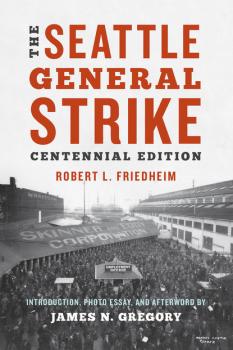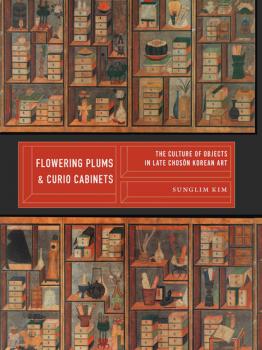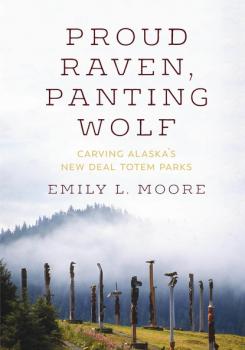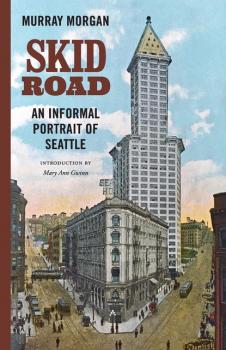ТОП просматриваемых книг сайта:
Историческая литература
Различные книги в жанре Историческая литература, доступные для чтения и скачиванияАннотация
�We are undertaking the most tremendous move ever made by LABOR in this country, a move which will lead�NO ONE KNOWS WHERE!� With these words echoing throughout the city, on February 6, 1919, 65,000 Seattle workers began one of the most important general strikes in US history. For six tense yet nonviolent days, the Central Labor Council negotiated with federal and local authorities on behalf of the shipyard workers whose grievances initiated the citywide walkout. Meanwhile, strikers organized to provide essential services such as delivering supplies to hospitals and markets, as well as feeding thousands at union-run dining facilities.Robert L. Friedheim�s classic account of the dramatic events of 1919, first published in 1964 and now enhanced with a new introduction, afterword, and photo essay by James N. Gregory, vividly details what happened and why. Overturning conventional understandings of the American Federation of Labor as a conservative labor organization devoted to pure and simple unionism, Friedheim shows the influence of socialists and the IWW in the city�s labor movement. While Seattle�s strike ended in disappointment, it led to massive strikes across the country that determined the direction of labor, capital, and government for decades. The Seattle General Strike is an exciting portrait of a Seattle long gone and of events that shaped the city�s reputation for left-leaning activism into the twenty-first century.
Аннотация
In early modern China, Jesuit missionaries associated with the male elite of Confucian literati in order to proselytize more freely, but they had limited contact with women, whose ritual spaces were less accessible. Historians of Catholic evangelism have similarly directed their attention to the devotional practices of men, neglecting the interior spaces in Chinese households where women worshipped and undertook the transmission of Catholicism to family members and friends. Nadine Amsler�s investigation brings the domestic and devotional practices of women into sharp focus, uncovering a rich body of evidence that demonstrates how Chinese households functioned as sites of evangelization, religious conflict, and indigenization of Christianity.The resulting exploration of gendered realms in seventeenth-century China reveals networks of religious sociability and ritual communities among women as well as women�s remarkable acts of private piety. Amsler�s exhaustive archival research and attention to material culture reveals new insights about women�s agency and domestic activities, illuminating areas of Chinese and Catholic history that have remained obscure, if not entirely invisible, for far too long.
Flowering Plums and Curio Cabinets - Sunglim Kim
Korean Studies of the Henry M. Jackson School of International StudiesАннотация
The social and economic rise of the chungin class (�middle people� who ranked between the yangban aristocracy and commoners) during the late Chos n period (1700�1910) ushered in a world of materialism and commodification of painting and other art objects. Generally overlooked in art history, the chungin contributed to a flourishing art market, especially for ch�aekk ri, a new form of still life painting that experimented with Western perspective and illusionism, and a reimagined style of the traditional plum blossom painting genre.Sunglim Kim examines chungin artists and patronage of the visual arts, and their commercial transactions, artistic exchange with China and Japan, and historical writings on art. She also explores the key role of men of chungin background in preserving Korean art heritage in the tumultuous twentieth century, including the work of the modern Korean collector and historian O Se-ch�ang, who memorialized many chungin painters and calligraphers.Revealing a vivid picture of a complex art world, Flowering Plums and Curio Cabinets presents a major reconsideration of late Chos n society and its material culture. Lushly illustrated, it will appeal to scholars of Korea and East Asia, art history, visual culture, and social history.
Информация о книге
Автор произведения Sunglim Kim
Серия Korean Studies of the Henry M. Jackson School of International Studies
Аннотация
Although demographically a minority in Kerala, India, Syrian Christians are not a subordinated community. They are caste-, race-, and class-privileged, and have long benefitted, both economically and socially, from their privileged position. Focusing on Syrian Christian women, Sonja Thomas explores how this community illuminates larger questions of multiple oppressions, privilege and subordination, racialization, and religion and secularism in India.In Privileged Minorities, Thomas examines a wide range of sources, including oral histories, ethnographic interviews, and legislative assembly debates, to interrogate the relationships between religious rights and women�s rights in Kerala. Using an intersectional approach, and US women of color feminist theory, she demonstrates the ways that race, caste, gender, religion, and politics are inextricably intertwined, with power and privilege working in complex and nuanced ways. By attending to the ways in which inequalities within groups shape very different experiences of religious and political movements in feminist and rights-based activism, Thomas lays the groundwork for imagining new feminist solidarities across religions, castes, races, and classes.
Аннотация
Among Southeast Alaska�s best-known tourist attractions are its totem parks, showcases for monumental wood sculptures by Tlingit and Haida artists. Although the art form is centuries old, the parks date back only to the waning years of the Great Depression, when the US government reversed its policy of suppressing Native practices and began to pay Tlingit and Haida communities to restore older totem poles and move them from ancestral villages into parks designed for tourists.Dramatically altering the patronage and display of historic Tlingit and Haida crests, this New Deal restoration project had two key aims: to provide economic aid to Native people during the Depression and to recast their traditional art as part of America�s heritage. Less evident is why Haida and Tlingit people agreed to lend their crest monuments to tourist attractions at a time when they were battling the US Forest Service for control of their traditional lands and resources. Drawing on interviews and government records, as well as the totem poles themselves, Emily Moore shows how Tlingit and Haida leaders were able to channel the New Deal promotion of Native art as national art into an assertion of their cultural and political rights. Just as they had for centuries, the poles affirmed the ancestral ties of Haida and Tlingit lineages to their lands.
Buddhas and Ancestors - Juhn Y. Ahn
Korean Studies of the Henry M. Jackson School of International StudiesАннотация
Two issues central to the transition from the Kory to the Chos n dynasty in fourteenth-century Korea were social differences in ruling elites and the decline of Buddhism, which had been the state religion. In this revisionist history, Juhn Ahn challenges the long-accepted Confucian critique that Buddhism had become so powerful and corrupt that the state had to suppress it. When newly rising elites (many with strong ties to the Mongols) used lavish donations to Buddhist institutions to enhance their status, older elites defended their own adherence to this time-honored system by arguing that their donations were linked to virtue. This emphasis on virtue and the consequent separation of religion from wealth facilitated the Confucianization of Korea and the relegation of Buddhism to the margins of public authority during the Chos n dynasty.
Информация о книге
Автор произведения Juhn Y. Ahn
Серия Korean Studies of the Henry M. Jackson School of International Studies
Аннотация
Skid Road tells the story of Seattle �from the bottom up,� offering an informal and engaging portrait of the Emerald City�s first century, as seen through the lives of some of its most colorful citizens. With his trademark combination of deep local knowledge, precision, and wit, Murray Morgan traces the city�s history from its earliest days as a hacked-from-the-wilderness timber town, touching on local tribes, settlers, the lumber and railroad industries, the great fire of 1889, the Alaska gold rush, flourishing dens of vice, general strikes, the 1962 World�s Fair, and the stuttering growth of the 1970s and �80s. Through it all, Morgan shows us that Seattle�s one constant is change and that its penchant for reinvention has always been fueled by creative, if sometimes unorthodox, residents.With a new introduction by Pulitzer Prize-winning book critic Mary Ann Gwinn, this redesigned edition of Murray Morgan�s classic work is a must for those interested in how Seattle got to where it is today.
Аннотация
What was sex like in China, from imperial times through the post-Mao era? The answer depends, of course, on who was having sex, where they were located in time and place, and what kind of familial, social, and political structures they participated in. This collection offers a variety of perspectives by addressing diverse topics such as polygamy, pornography, free love, eugenics, sexology, crimes of passion, homosexuality, intersexuality, transsexuality, masculine anxiety, sex work, and HIV/AIDS. Following a loose chronological sequence, the chapters examine revealing historical moments in which human desire and power dynamics came into play. Collectively, the contributors undertake a necessary historiographic intervention by reconsidering Western categorizations and exploring Chinese understandings of sexuality and erotic orientation.
Аннотация
From Lake Coeur d�Alene to its confluence with the Columbia, the Spokane River travels 111 miles of varied and often spectacular terrain�rural, urban, in places wild. The river has been a trading and gathering place for Native peoples for thousands of years. With bountiful trout, accessible swimming holes, and challenging rapids it is a recreational mecca for residents and tourists alike. The Spokane also bears the legacy of industrial growth and remains caught amid interests competing over natural resources.The twenty-eight contributors to this collection�including activists, storytellers, and scientists�profile this living river through personal reflection, history, science, and poetry. They bring a keen environmental awareness of resource scarcity, climate change, and cultural survival tied to the river�s fate.
Аннотация
Arguing that our definition of Islamic journalism is too narrow, this study examines day-to-day journalism as practiced by Muslim professionals at five exemplary news organizations in Malaysia and Indonesia.At Sabili, established as an underground publication, journalists are hired for their ability at dakwah, or Islamic propagation. At Tempo, a news magazine banned during the Soeharto regime, the journalists do not talk much about sharia law; although many are pious and see their work as a manifestation of worship, the Islam they practice is often viewed as progressive or even liberal. At Harakah reporters support an Islamic political party, while at Republika they practice a �journalism of the Prophet.� Secular news organizations, too, such as Malaysiakini, employ Muslim journalists. Janet Steele explores how these various publications observe universal principles of journalism and do so through an Islamic idiom.
Информация о книге
Автор произведения Janet Steele










